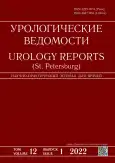Выбор доступа при эндоскопическом лечении пациентов с конкрементами проксимального отдела мочеточника. Наш опыт
- Авторы: Топузов М.Э.1, Басок С.М.1, Кустов П.В.1, Абинов О.А.1
-
Учреждения:
- Северо-Западный государственный медицинский университет им. И.И. Мечникова
- Выпуск: Том 12, № 1 (2022)
- Страницы: 49-54
- Раздел: Оригинальные исследования
- Статья получена: 21.12.2021
- Статья одобрена: 30.03.2022
- Статья опубликована: 26.04.2022
- URL: https://journals.eco-vector.com/uroved/article/view/90771
- DOI: https://doi.org/10.17816/uroved90771
- ID: 90771
Цитировать
Полный текст
Аннотация
Актуальность. Мочекаменная болезнь — актуальная проблема урологии. За прошедшие 20 лет тактика лечения больных уролитиазом существенно изменилась. Однако в настоящее время отсутствуют стандартизированные алгоритмы выбора наиболее эффективного лечения конкретного пациента.
Цель — оценка эффективности и безопасности использования мини-нефроскопа в сравнении с использованием гибкого уретерореноскопа при выполнении перкутанной антеградной уретеролитотрипсии в лечении пациентов с конкрементами проксимального отдела мочеточника.
Материалы и методы. Проведен ретроспективный анализ историй болезни 61 пациента с конкрементами проксимального отдела мочеточника. Для оперативного лечения все больные были госпитализированы в плановом порядке с ранее установленным нефростомическим дренажом 12Ch. Всем выполняли перкутанную антеградную уретеролитотрипсию: 15 — с использованием мини-нефроскопа (1-я группа) и 46 — гибкого уретерореноскопа (2-я группа).
Результаты. Клиническая эффективность использования для уретеролитотрипсии мини-нефроскопа и гибкого уретерореноскопа сходна. У пациентов 1-й и 2-й групп не достоверно не различались средняя продолжительность операции (соответственно 59 ± 10 и 63 ± 9 мин, p > 0,1) и коэффициент Stone Free Rate (SFR) в первые сутки после операции (соответственно 93,3 и 95,7 %). Интраоперационных осложнений не было ни у одного пациента. Частота послеоперационных осложнений в 1-й и 2-й группах была низкой, все осложнения соответствовали I степени по классификации Clavien – Dindo. Продолжительность послеоперационного пребывания в стационаре у больных 1-й и 2-й групп была одинаковой и составила в среднем 3 сут.
Заключение. Выполнение перкутанной антеградной уретеролитотрипсии с помощью нефроскопа и гибкого уретерореноскопа обеспечивает достижение SFR в одинаково короткие сроки, минимальную длительность оперативного вмешательства и продолжительность послеоперационного койко-дня, а также низкую частоту послеоперационных осложнений.
Полный текст
Об авторах
Марлен Эскендерович Топузов
Северо-Западный государственный медицинский университет им. И.И. Мечникова
Email: martop@mail.ru
ORCID iD: 0000-0001-7765-0122
SPIN-код: 3061-6420
Scopus Author ID: 23979017100
Д-р мед. наук, профессор кафедры урологии
Россия, 191015, Санкт-Петербург, ул. Кирочная, д. 41Станислав Михайлович Басок
Северо-Западный государственный медицинский университет им. И.И. Мечникова
Email: stas_basok@mail.ru
ORCID iD: 0000-0003-2173-7485
SPIN-код: 7142-8167
Врач-уролог Клиники имени Петра Великого
Россия, 191015, Санкт-Петербург, ул. Кирочная, д. 41Петр Владимирович Кустов
Северо-Западный государственный медицинский университет им. И.И. Мечникова
Email: wisttut@gmail.com
ORCID iD: 0000-0002-4075-3205
Аспирант кафедры урологии
Россия, 191015, Санкт-Петербург, ул. Кирочная, д. 41Осман Арсланбекович Абинов
Северо-Западный государственный медицинский университет им. И.И. Мечникова
Автор, ответственный за переписку.
Email: osmanabinov1111@mail.ru
ORCID iD: 0000-0003-1510-7612
SPIN-код: 2285-5446
Клинический ординатор кафедры урологии
Россия, 191015, Санкт-Петербург, ул. Кирочная, д. 41Список литературы
- Scales C.D. Jr, Smith A.C., Hanley J.M., Saigal C.S.; Urologic Diseases in America Project. Prevalence of kidney stones in the United States // Eur Urol. 2012. Vol. 62, No. 1. P. 160–165. doi: 10.1016/j.eururo.2012.03.052
- Каприн А.Д., Аполихин О.И., Сивков А.В., и др. Анализ уронефрологической заболеваемости и смертности в Российской Федерации за период 2002–2014 гг. по данным официальной статистики // Экспериментальная и клиническая урология. 2016. № 3. С. 4–13.
- Аполихин О.И., Сивков А.В., Солнцева Т.В., и др. Эпидемиология МКБ в различных регионах РФ по данным официальной статистики. Материалы российской научной конференции с международным участием «Мочекаменная болезнь: фундаментальные исследования, инновации в диагностике и лечении» // Саратовский научно-медицинский журнал. 2011. Т. 7, № 2 (прил.). С. 120.
- Глыбочко П.В., Лопаткин Н.А., Аляев Ю.Г., Ахвледиани Н.Д. Диагностика и лечение мочекаменной болезни. Что изменилось за последние 20 лет? // Саратовский научно-медицинский журнал. 2011. Т. 7, № 2 (прил.). С. 9–12.
- Marickar Y.M., Vijay A. Female stone disease: the changing trend // Urol Res. 2009. Vol. 37. P. 337–340. doi: 10.1007/s00240-009-0216-2
- Gu X.J., Lu J.L., Xu Y. Treatment of large impacted proximal ureteral stones: randomized comparison of minimally invasive percutaneous antegrade ureterolithotripsy versus retrograde ureterolithotripsy // World J Urol. 2013. Vol. 31. P. 1605–1610. doi: 10.1007/s00345-013-1026-2
- Elgebaly O., Abdeldayem H., Idris F., et al. Antegrade mini-percutaneous flexible ureteroscopy versus retrograde ureteroscopy for treating impacted proximal ureteric stones of 1–2 cm: A prospective randomised study // Arab J Urol. 2020. Vol. 18, No. 3. P. 176–180. doi: 10.1080/2090598X.2020
Дополнительные файлы








